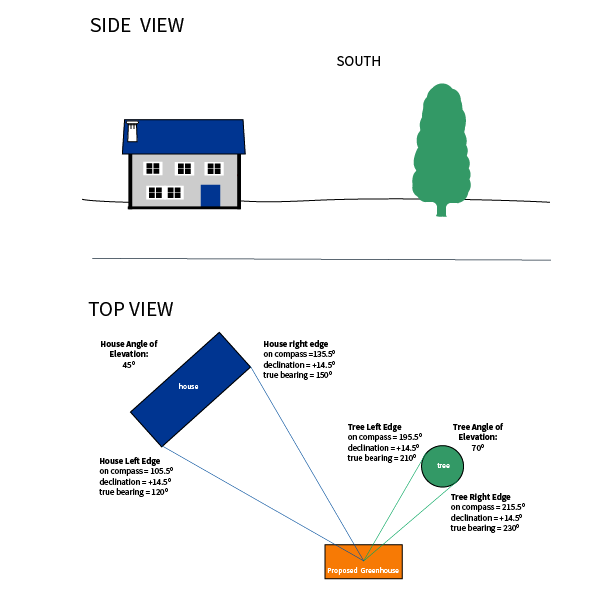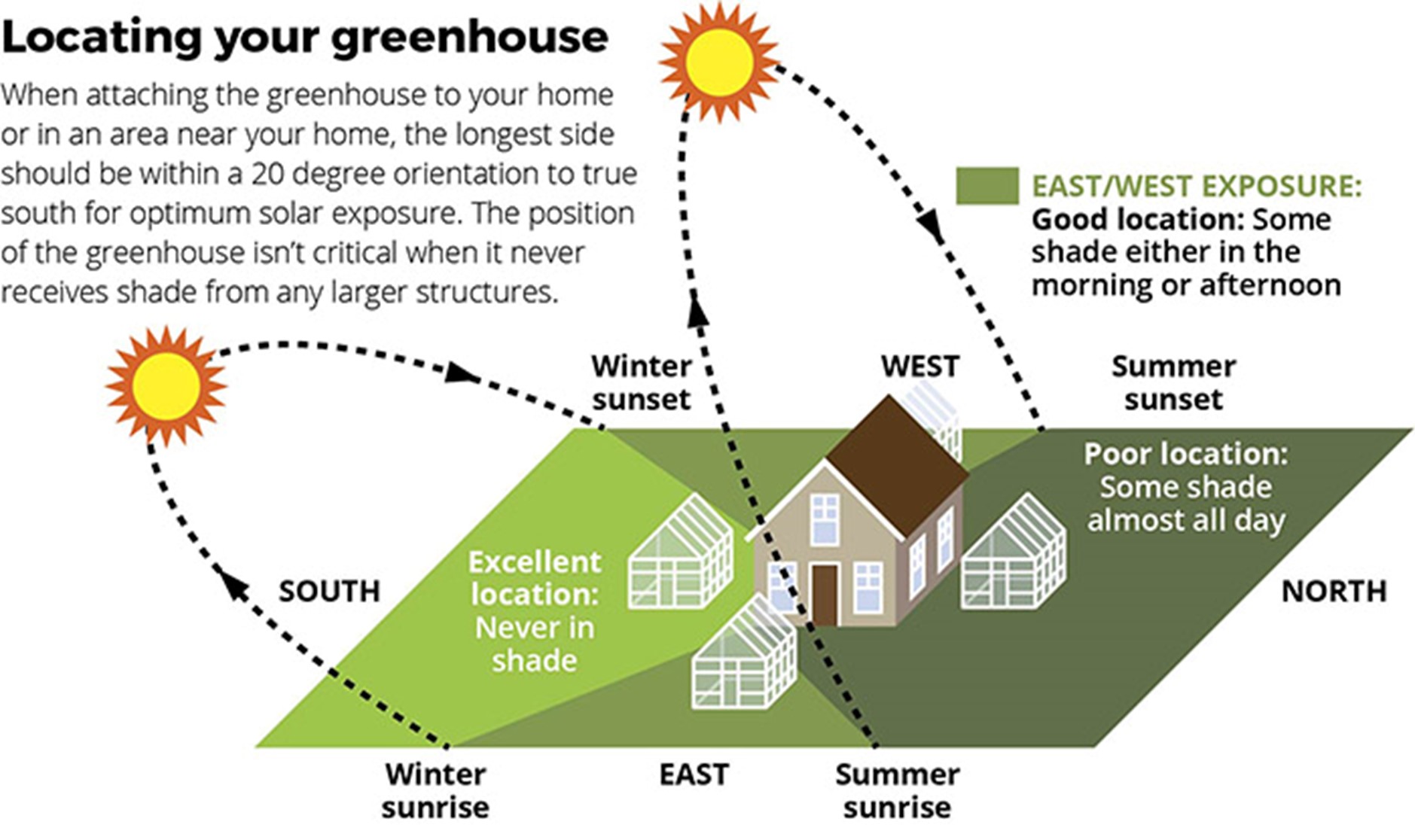To orient a greenhouse to the sun, position it along an east-west axis. This maximizes sunlight exposure throughout the day.
A well-oriented greenhouse can significantly enhance plant growth and health. Proper sunlight exposure is essential for photosynthesis, allowing plants to thrive. The ideal orientation takes advantage of the sun’s path, ensuring that plants receive consistent light. Different climates may require slight adjustments, but the general principle remains the same.
A greenhouse should also consider local topography and obstacles that may block sunlight. This strategic positioning not only boosts plant productivity but also improves energy efficiency within the structure. Understanding these factors can help gardeners create an optimal environment for their plants, leading to a flourishing greenhouse garden.

Credit: extension.unh.edu
How to Orient a Greenhouse to the Sun : Step by Step Guide
The Importance Of Sunlight In Greenhouse Gardening
Sunlight is vital for greenhouse gardening. It helps plants grow strong and healthy. Photosynthesis is the process where plants use sunlight to make food. Without enough light, plants cannot thrive. This affects their growth and flowering.
Plants need different light levels. Some prefer full sun, while others like partial shade. The right amount of light can lead to better yields. Understanding these needs is key for any gardener.
Choosing the right orientation for a greenhouse ensures maximum sunlight. Positioning it to face the sun allows plants to absorb more energy. This leads to healthier plants and a more fruitful garden.
Factors Affecting Greenhouse Orientation
Geographical location plays a big role in greenhouse orientation. Areas closer to the equator get more direct sunlight. This means they need different angles for the greenhouse. Northern and southern regions require careful placement to catch sunlight.
Seasonal variations also affect how to position a greenhouse. In winter, the sun is lower in the sky. This requires a south-facing orientation for maximum light. During summer, a slight tilt can help reduce overheating.
Understanding both factors is crucial. Proper orientation helps plants grow better. It also improves energy efficiency in the greenhouse.
Analyzing Sun Path For Optimal Orientation
Understanding solar angles is key for greenhouse orientation. Tools like a solar pathfinder can help visualize sunlight. Using a compass shows the best direction for sunlight exposure.
Techniques include observing the sun’s position at different times. Marking the sun’s path helps find optimal spots. Shadows cast by nearby objects can affect sunlight too.
| Tool/Technique | Purpose |
|---|---|
| Solar Pathfinder | Visualize sunlight throughout the year |
| Compass | Determine the direction of sunlight |
| Sun Path Observation | Track sunlight at various times |
| Shadow Analysis | Identify obstacles affecting light |
East-west Vs. North-south Orientation
Choosing the right orientation for your greenhouse is crucial. Each direction has its own pros and cons.
| Orientation | Pros | Cons |
|---|---|---|
| East-West | Maximizes sunlight in the morning and evening. | May receive less light during midday. |
| North-South | Provides even light throughout the day. | Can lead to overheating in summer. |
For best results, consider local climate and sun patterns. Proper ventilation also helps maintain a stable temperature. Position your greenhouse away from tall buildings or trees. This ensures maximum light exposure throughout the day.
Adjusting For Obstructions And Shadows
Identifying potential blockages is essential for optimal greenhouse orientation. Look for trees, buildings, and other structures that can block sunlight. Observe how shadows move throughout the day. This helps in finding the best orientation for your greenhouse.
Use these mitigation strategies to reduce shadow impact:
- Trim trees or shrubs that cast shadows.
- Choose greenhouse locations away from tall buildings.
- Consider using reflective materials to bounce light.
- Plant lower crops that won’t shade the greenhouse.

Credit: arcadiaglasshouse.com
Incorporating Passive Solar Design Principles
Thermal mass helps store heat from the sun. Use materials like concrete, bricks, or water barrels. These materials absorb heat during the day and release it at night. This keeps the greenhouse warm and stable.
Insulation techniques are crucial for maintaining temperature. Use double-layered plastic or polycarbonate panels for walls and roofs. These materials trap air, acting as a barrier to heat loss. Insulated curtains can also help keep warmth inside during cold nights.
Choose the right location for your greenhouse. Position it to receive maximum sunlight throughout the day. Avoid placing it near tall trees or buildings that block the sun.
Seasonal Adjustments For Greenhouse Orientation
Proper greenhouse orientation is key for maximizing sunlight. In winter, position your greenhouse to face south. This helps capture the most sunlight. Use reflective materials on the north side to boost light. Keep plants warm during the cold months.
For summer, adjust the angle slightly to prevent overheating. Increase ventilation by opening windows and doors. Shade cloths can protect sensitive plants from harsh sunlight. Ensure the greenhouse remains cool while still receiving light.
Advanced Tips For Maximizing Sunlight Exposure
Using reflective materials can boost sunlight inside your greenhouse. Consider applying white paint or reflective film on nearby surfaces. These materials help redirect sunlight into your greenhouse.
Adjustable panels are another great option. They can be tilted to capture the sun at different angles. This flexibility ensures that your plants receive the most light throughout the day.
Installing shutters or screens can also help. These can be opened or closed based on sunlight levels. This way, you can control the amount of light entering.

Credit: www.youtube.com
Frequently Asked Questions
How Should I Orient My Greenhouse For Sunlight?
To maximize sunlight exposure, orient your greenhouse north to south. This alignment allows for even light distribution throughout the day. Additionally, consider the local climate and potential obstructions like trees or buildings. Proper orientation helps plants thrive and enhances overall growth rates.
What Angle Is Best For Greenhouse Roof?
A roof angle of 30 to 45 degrees is ideal. This angle allows for optimal sunlight capture throughout the year. Adjust the angle based on your geographic location and seasonal sun path. A well-angled roof can significantly improve light penetration and reduce overheating.
Can I Use Shade Cloth In My Greenhouse?
Yes, shade cloth can protect plants from excessive sunlight. It helps regulate temperature and prevents leaf burn during hot days. Choose the appropriate shade percentage based on your plant needs. Proper use of shade cloth promotes healthy growth and better yield.
How Do I Track Sunlight In My Garden?
Use a sunlight tracker or observe daily light patterns. Mark areas that receive the most sunlight and those that are shaded. This information will help you decide where to place your greenhouse. Understanding sunlight distribution ensures optimal plant growth and productivity.
Conclusion
Proper orientation of your greenhouse is key to maximizing sunlight exposure. By positioning it correctly, you can enhance plant growth and improve yields. Remember to consider seasonal changes and local climate. With the right setup, your greenhouse can thrive year-round, providing you with a bountiful harvest.
Enjoy your gardening journey!

